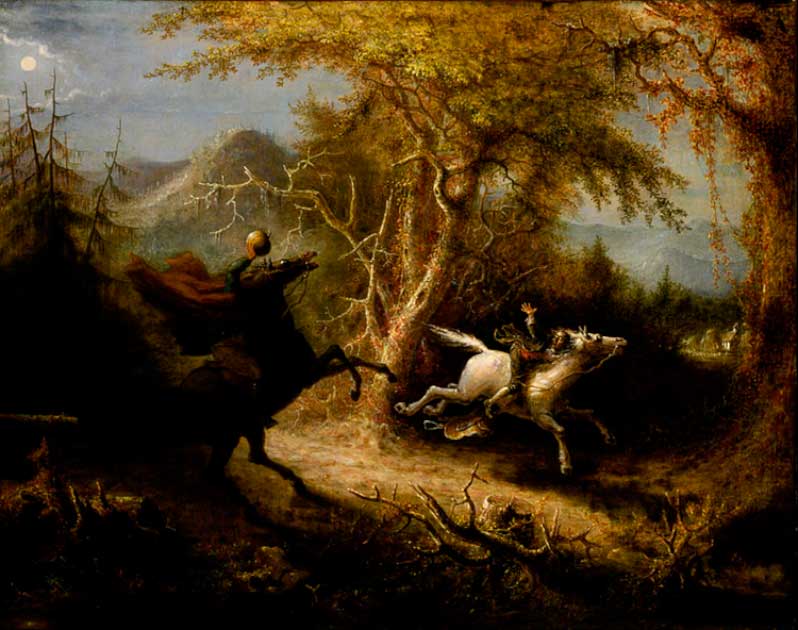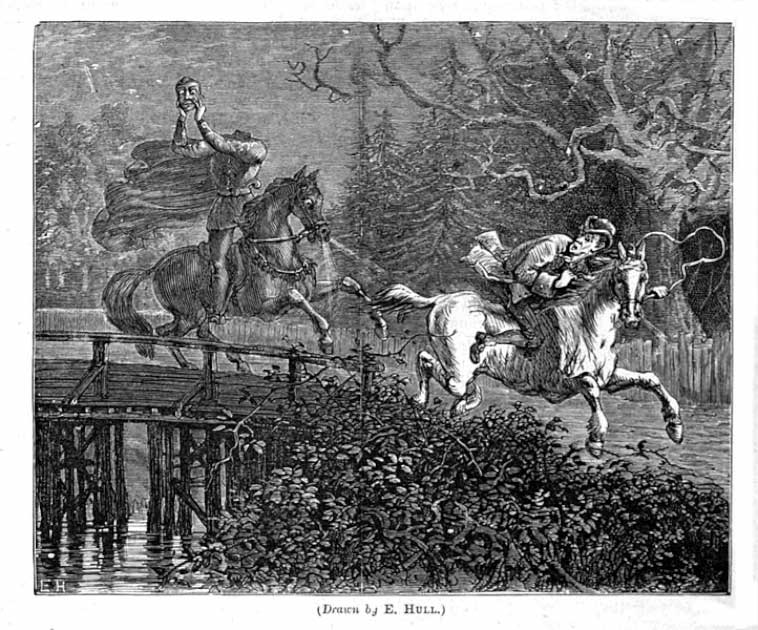The legend of Sleepy Hollow, and the stories of the headless horseman, are infamous in both histories and in the media. There have been a TV series and countless films.
But behind the Hollywood excess and the supernatural fiction there is a surprising amount of historical background that is used by these, and the series Sleepy Hollow takes a real twist, taking a historical basis and spinning it into a captivating story. There are references from the Boston Tea Party to Benjamin Franklin’s obsession with electricity and the weather.
However, the main focus is of course the tale of the Headless Horseman. This is inspired by Washington Irving’s short story “The Legend of Sleepy Hollow” but what is it and how true is the story?
The Legend
The legend is set on the Eastern Shore of the Hudson River in New York state. The town the tale is set in is around 3 miles (5 km) from Tarrytown. The town is called Sleepy Hollow, which was the name given by the founders of the town from Holland.
It is said that the town was given this name because of its atmosphere and the supernatural incidents that occurred. Witches and other ghouls were said to haunt the town. One of the most famous ghouls was the Headless Horseman.
The legend has it that he was a Hessian soldier, a German who served in the British Army during the American Revolutionary war, who would gallop around the Hollow without his head on horseback. But he was only seen in the distance, and only at night.

The short story focuses on the main character, a local school teacher, called Ichabod Crane who is an odd character. He enjoys singing and is renowned for his dancing but more importantly, he has mastered the History of New England Witchcraft by Cotton Mather.
- Werewolf Legends from Around the World
- The Blood Countess of Hungary: Was Elizabeth Báthory a Vampire?
Irving describes this character as an extremely tall man with narrow shoulders. He closely resembled a scarecrow that had escaped from a cornfield. This puts him in direct opposition to the other principle character Tom Mison who is handsome and charming.
Crane attends a party that the local Duchess Katrina Van Tassel, who he hopes to court, is throwing. Everyone from the town is attending and whilst there they all share ghost stories revolving around the Headless Horseman.
Many recount stories with the Horseman who lurked in the churchyard cemetery. Crane’s attempt to court the Duchess fails miserably and she instead chooses to leave with Brom Van Brunt. Crane leaves the party dejected and on his return home, the Headless Horseman appears to him forcing him to flee.
The next morning, Ichabod’s horse returned but with no rider. When the school had no teacher, the townsfolk began to worry. The saddle of the horse is discovered along with a destroyed pumpkin, but Crane never reappears. His fate is unknown and left up to the imagination. According to other tales, he was spirited away by supernatural means.
The Irish Myth
The story of the Headless Horseman also seems to have roots in a much more gruesome depiction out of Irish culture. The Dullahan, Durahan or Dullaghan, or the Gan Ceann are all names of an Irish mythological creature that is portrayed as a headless rider on a black horse.
When he gallops through the night, he carries his own head held high. The legend has been said to be the embodiment of the Celtic god Crom Dubh from the 12th century.

This legend claims that the Dullahan’s house originated in Ireland. He is always depicted as a Headless Horseman on a black horse. The mouth of his head is always in a hideous grin that touches both sides of his head. The eyes of the head constantly move so that he can see across the countryside even when it is at its darkest.
- The Bell Witch: True Inspiration for a Movie Franchise?
- The Exorcism of Roland Doe: The Events That Inspired The Exorcist?
The head itself is the color of moldy cheese. As a horsewhip, the Dullahan used the spine of a human corpse and the wagon that he pulled along would be adorned with funeral objects. Additionally, there were skulls on the wagon with candles to light the way and the wheels were made of thigh bones.
The Irish believed that when he stopped riding, a person would soon die. If he was to call out a person’s name then he would steal the soul of that person, killing that person. The only way to defeat him would be to produce golden objects which would force him to disappear.
Is there any Truth to It?
Irving wrote that his story was based on local folklore based on a ghost of a Hessian soldier who was beheaded in battle within the town and so he continued to haunt it. However, others believe that the story was inspired by Dutch settlers who told a story about a Wild Huntsman, who would chase people through the woods a night.
The town of Sleepy Hollow is thought to have been based on a nearby town called Kinderhook in New York. The village of North Tarrytown though renamed itself to become Sleepy Hollow in 1996.
What adds real validity to the story is that there has been found in the historical record a man named Ichabod Crane. He was born in New Jersey in 1787 and served as a soldier in New York. Washington Irving is said to have met him and found his name so interesting because it sounded like a schoolteacher. The character of Crane was based on a schoolmaster that Irving had befriended within Kinderhook.
So, there was a real Ichabod Crane. And we know that a Hessian soldier would not be so very lost were he to chance upon this place, separated from his troop in the Revolutionary war.
Such a man, an enemy to the locals, might come to a sticky end out on his own in the woods of upstate New York. Such a man might be murdered.
And the ghost of such a murdered man might be out for revenge.
Top Image: The headless horseman haunts upstate New York. Source: GARETH / Adobe Stock.
By Kurt Readman